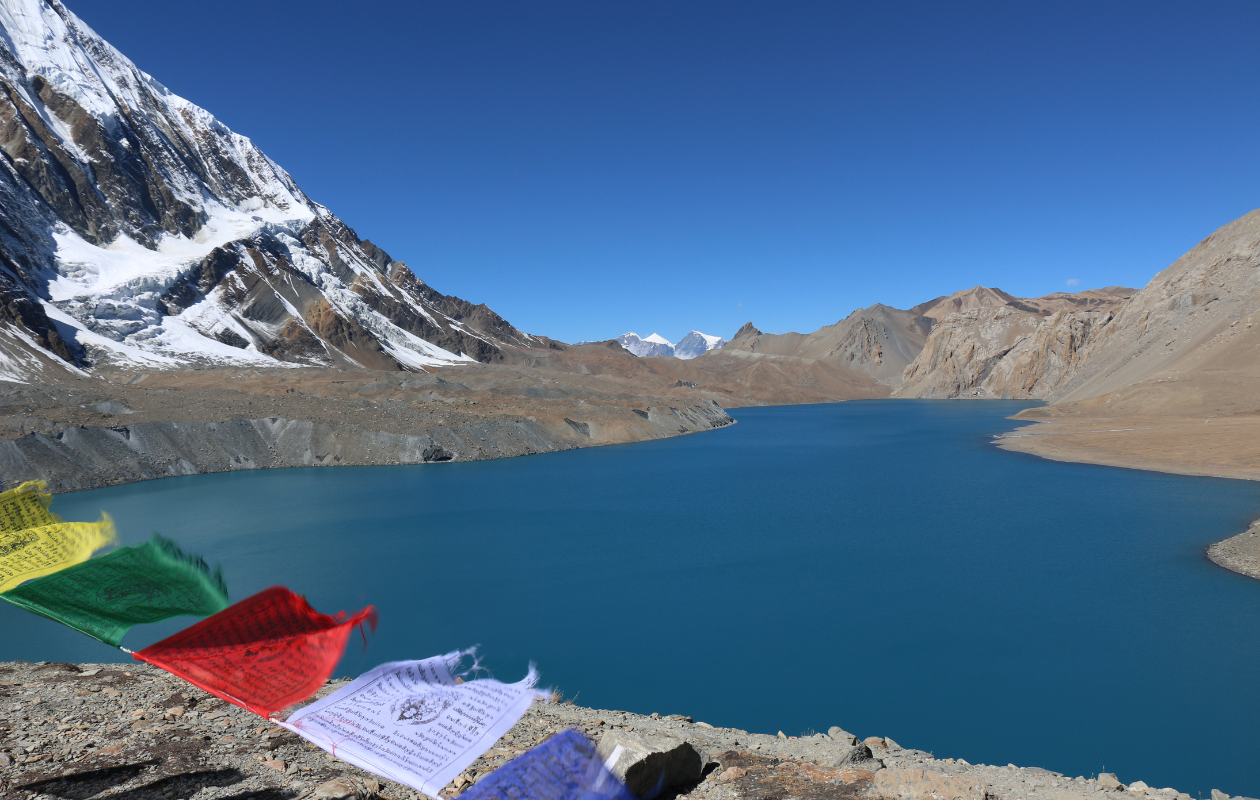Introduction
This extraordinary trek takes trekkers deep into the heart of the Annapurna Region of Nepal. It is an unforgettable experience of natural beauty and high-altitude trekking, and it is one of Nepal’s most famous. Tilicho Lake, at 4919 meters, is one of the highest lakes in the world and Nepal’s highest. It is renowned for its crystal-clear blue waters surrounded by towering snow-capped peaks, including some of the tallest in the world.
Kathmandu is the starting point for the trek, and Chame is where you’ll start your walk to the lake. This trek is filled with trekkers throughout the year. Pushed right up against the great wall of the Annapurna range, and with glaciers crashing down into it, the lake remains frozen for months. Moreover, beautiful landscapes, valleys, green hills, dense forests, and artistic waterfalls are some of the highlights of this trek. Let us know more about this amazing journey.
Important Facts of the Tilicho Lake
- Maximum Elevation: 4919 meters
- Trek’s Starting Point: Kathmandu
- Trek’s Destination: Tilicho Lake
- Duration: Approx. 12 days
- Difficulty: Moderate-Challenging
- Accommodation: Tea Houses and Lodges
Highlights of the Trek:
- Trek through the Marsyangdi River bank: Along your trek, you’ll witness a change in topography as you ascend through the Marsyangdi River’s bank. You can find an abundance of animals and plant species. You’ll also encounter numerous villages where you can interact with the locals. The river becomes narrower as you ascend in elevation. The bluish-colored river is one of the picturesque sights of the trek.
- Cultural Immersion: The trek passes through several villages in the Manang region. These villages allow trekkers to experience Tibetan-influenced culture, monasteries, and the unique lifestyle of the local Gurung and Thakali people. Not only is this trek naturally gifted, but it is also one of the few treks where trekkers get a cultural insight into the region.
- Nepal’s Highest Lake: The trek’s main highlight is probably the Tilicho Lake. The turquoise waters of Tilicho Lake, surrounded by snow-capped mountains, offer breathtaking and serene views. You get a sense of achievement when you reach the Lake.
- Transition in Landscape: As you ascend from Chame, you’ll witness drastic changes in the region’s landscape. From lush green surroundings to dry, barren landscapes, trekkers get to experience the differences in the landscape as they ascend.
- Annapurna Region’s Views: As part of the Annapurna circuit, trekkers can enjoy the picturesque views of the Annapurna, Nilgiri, and Dhaulagiri ranges.
Itinerary
- Day 1- Drive from Kathmandu to Jagat, 1330m.
- Day 2- Trek from Jagat to Dharapani, 1960m.
- Day 3- Trek from Dharapani to Chame, 2630m.
- Day 4- Trek from Chame to Pisang, 3210m.
- Day 5- Trek from Pisang to Manang, 3540m.
- Day 6- Trek from Manang to Khangsar Village, 3734m.
- Day 7- Trek from Khangsar Village to Tilicho Base Camp, 4250m.
- Day 8- Trek from Tilicho Base Camp to Tilicho Lake and back to Tilicho Base Camp, 4919m.
- Day 9- Trek from Tilicho Base Camp to Manang Village, 3540m.
- Day 10- Trek to Chame, 2650m.
- Day 11- Drive back to Kathmandu, 1400m.

What To Pack For The Tilicho Lake Trek:
- Clothing: Pack warm clothes for the trek, as Tilicho can get pretty cold. A good set of clothes can make a huge difference on your trek. Carry gloves, hats, and insulation-layered clothes. Good sturdy trekking boots are recommended for your feet, as they can support your ankle throughout the trek.
- Accessories: Carry a good backpack with a minimum of 30-40l of space. This can be helpful for carrying other essentials like water, electronics, food, etc. You may also carry sunglasses and sleeping bags for extra assistance during the trek.
- Documents: TIMS and ACAP cards are necessary for trekking in this region. Carry enough cash throughout the journey, as no ATM facilities are at the top. These permits can be obtained in Pokhara or Kathmandu.
- First Aid Kits: Carry medicines and first aid kits.
Best Time For This Trek
It is best to trek here during the spring and autumn seasons. However, there are many trekkers in this region during these times. The weather is stable, and the views are crystal clear. Avoid the monsoon and winter, as the trails are affected by snow and rain.
Conclusion
This trek offers a blend of natural beauty alongside cultural insight into the Manang region. If you want to trek to this place, be sure to stay on the designated trail, carry enough essentials, acquire all the necessary permits, obey the rules, and respect local culture and traditions.
Also Read: Nar Phu Valley Trek: An Offbeat Himalayan Adventure


0 Comment